Analysis of Fishery Resource Management Practices in São Tomé and Príncipe: Perception of the Dynamics of Catches from 1950–2020, Recommendations and Strategies for Future Research
Abstract
:1. Introduction
2. Materials and Methods
2.1. Statistical Collection Data
2.2. Study Area Description
2.3. Data Analysis
3. Results
3.1. Overview of the Socio-Economic Benefits and Potentials of STP Fish Resources
3.2. Employment Distribution in the Fisheries Sector in São Tomé and Príncipe
Small-Scale Fishing Fleet from 1950 to 2020
3.3. Ratio of Catch per Unit Effort of Vessel Type and Fishing Gear
Estimated Total Effort from the Total Number of Trips
3.4. Composition of the Disembarked Catch
3.4.1. Trends in the Distribution of Fishing Effort Catches by Districts
3.4.2. The Composition of Pelagic and Demersal Landed Catches
3.5. Catch by Fishing Fleet Effort
3.5.1. Catches of the Artisanal Fishery Fleets from 1950 to 2020
3.5.2. Trends of the Capture of Semi-Industrial Fishing Fleets from 1950 to 2020
3.5.3. Foreign Industrial Fishing Fleets from 1980 to 2020
3.5.4. The Overall Re-Constituted Catch Effort Trend
4. Discussion
5. A Perspective on Fisheries Management Measures
6. Conclusions and Recommendations for Future Research Work
- Improvements in fishing catch data collection, monitoring, and updating;
- Biology research, population dynamics, stock assessment, control of fishing effort, and establishment of TACs in all catch areas are paramount and necessary for proper management. This measure will help clarify the catch potential in São Tomé and Príncipe waters and minimize pressure on the resource.
- The implementation of a community-based co-management model for commercial fisheries in São Tomé and Príncipe. This model would help the government to improve implementation capacities in the process of shared governance and decision making in local communities related to sustainable and participatory management of fisheries in the coastal zone.
Author Contributions
Funding
Institutional Review Board Statement
Informed Consent Statement
Data Availability Statement
Acknowledgments
Conflicts of Interest
References
- Pauly, D.; Zeller, D. Catch reconstructions reveal that global marine fisheries catch are higher than reported and declining. Nat. Commun. 2016, 7, 1–9. [Google Scholar] [CrossRef] [PubMed] [Green Version]
- FAO. Programa Integrado de Reestruturação da Pesca. Relatório FAO/SFC/STP. 2009, p. 67. Available online: https://docs.wfp.org/api/documents/WFP-0000070152/download/ (accessed on 10 May 2021).
- Belhabib, D.; Pauly, D. Fisheries Catch Reconstructions: West Africa, Part II, Fisheries Centre Research Reports Fisheries Centre; University of British Columbia: Vancouver, BC, Canada, 2015; Volume II, pp. 37–50. [Google Scholar]
- Costa, F.C. Estudos de Pescas em S. Tomé e Príncipe; Expedition Report 8; Ministério Junta Investigação Ultramarino: São Tomé, São Tomé e Príncipe, 1959; pp. 219–271. [Google Scholar]
- Djiénouassi, S. Avaliação da Contribuição da Pesca Marítma Artesanal Para o PIB dos Países Membros da COREP; Food and Agriculture Organization of the United Nations: Rome, Italy, 2016; p. 24. [Google Scholar]
- FAO. The State of World Fisheries and Aquaculture—Meeting the Sustainability in Action; FAO: Rome, Italy, 2020. [Google Scholar] [CrossRef]
- Obiero, K.; Meulenbroek, P.; Drexler, S.; Dagne, A.; Akoll, P.; Odong, R.; Kaunda-Arara, B.; Waidbacher, H. The Contribution of Fish to Food and Nutrition Security in Eastern Africa: Emerging Trends and Future Outlooks. Sustainability 2019, 11, 1636. [Google Scholar] [CrossRef] [Green Version]
- Muringai, R.T.; Mafongoya, P.; Lottering, R.T.; Mugandani, R.; Naidoo, D. Unlocking the Potential of Fish to Improve Food and Nutrition Security in Sub-Saharan Africa. Sustainability 2021, 14, 318. [Google Scholar] [CrossRef]
- Espírito Santo, S.; Carvalho, P.B. Food Consumption, Food Chains and Market Evolution in São Tomé e Principe: A Case Study in Su-Saharan Africa; Instituto Suprior Politécnico de São Tomé e Principe: Sao Tome, São Tomé and Príncipe, 2010; p. 18. [Google Scholar]
- Garcia, S.M.; Prouzet, P. Towards the implementation of an integrated approach to fisheries resources management in Ifremer, France. Aquat. Living Resour. 2009, 22, 381–394. [Google Scholar] [CrossRef] [Green Version]
- Adelino, F.; Moniz, E.; Nascimento, M. Evaluation de la Contribution Socio-Economique de la Peche au PIB et au Developpement de Sao Tome e Principe; Sustainable Fisheries Livelihoods Programme; DFID: London, UK; FAO: Rome, Italy, 2005; p. 20. [Google Scholar]
- Belhabib, D.; Greer, K.; Pauly, D. Trends in Industrial and Artisanal Catch Per Effort in West African Fisheries. Sea Around Us, Institute for the Oceans and Fisheries; The University of British Columbia: Vancouver, BC, Canada, 2016; pp. 332–2202. [Google Scholar]
- FAO. Estratégia de Transição da Economia Azul Para SãoTomé e Príncipe; FAO: Rome, Italy, 2021; Available online: https://www.fao.org/publications/card/fr/c/CB5913PT/ (accessed on 9 April 2020).
- Afonso, P.F.M.; Porteiro, R.S.; Santos, J.P.; Barreiros, J.; Worms, J.; Wirtz, P. Coastal marine fishes of São Tomé Island (Gulf of Guinea). Arquipélago Life Mar. Sci. 1999, 17, 65–92. [Google Scholar]
- Lee, Y.-J.; Su, N.-J.; Lee, H.-T.; Hsu, W.; Liao, C.-H. Application of Métier-Based Approaches for Spatial Planning and Management: A Case Study on a Mixed Trawl Fishery in Taiwan. J. Mar. Sci. Eng. 2021, 9, 480. [Google Scholar] [CrossRef]
- Scopa, A.; Nkawambi, W.; Delbaere, J.; Salvaterra, H.; Bongi, S. Republique democratique de Sao Tome et Principe. Analyse Globale de la Sécurité Alimentaire et de la Vulnérabilité. São Tomé. 2009. Available online: http://documents.wfp.org/stellent/groups/public/documents/ena/wfp196154.pdf (accessed on 10 February 2021).
- Vasconcelos, M. Um Olhar Diferente para o Futuro-Os Oceanos e a ‘Sustentabilidade’ das Pescas; Comunicação Apresentada no Seminário Sobre a Convenção Europeia-Convencionar ou Constitucionalizar a Reforma das Políticas; UALG: Faro, Portugal, 2003. [Google Scholar]
- Froese, R.; Kesner-Reyes, K. Impact of fishing on the abundance of marine species. J. Mar. Sci. 2002, 12, 1–12. [Google Scholar]
- Moniz, A.; Godinho, M.M. New Methodological Approaches for Change in Traditional Sectors: The Case of the Portuguese Fisheries Socio-Economic System. Econ. Soc. 2000, 5, 63–77. [Google Scholar]
- Alegre, M.-C.C. Towards a National Ocean Policy in Sao Tome and Principe; The United Nations-Nippon Foundation Fellowship Programme 2009–2010; The United Nations: New York, NY, USA, 2009; Volume 76. [Google Scholar]
- Anon. Atelier Paris 21 pour l’Afrique du Centre sur l’utilisation des Statistiques dans les Politiques de Lutte Contre la Pauvrete et de Developpemen; Democratic Republic of Sao Tome and Principe: Sao Tome, São Tomé and Príncipe, 2002; p. 26. [Google Scholar]
- Belhabib, D.; Cheung, W.W.L.; Kroodsma, D.; Lam, V.W.Y.; Underwood, P.J.; Virdin, J. Catching industrial fishing incursions into inshore waters of Africa from space. Fish Fish. 2019, 21, 379–392. [Google Scholar] [CrossRef]
- Costello, C.; Ovando, D. Status, Institutions, and Prospects for Global Capture Fisheries. Annu. Rev. Environ. Resour. 2019, 44, 177–200. [Google Scholar] [CrossRef]
- Téla Non. Nova lei da pesca dá Mais liberdade a Guarda Costeira no Combate a Pesca Ilegal. Available online: https://www.telanon.info/politica/2021/11/22/35732/nova-lei-da-pesca-da-mais-liberdade-a-guarda-costeira-no-combate-a-pesca-ilegal/ (accessed on 16 January 2022).
- Caddy, J.F.; Mohon, R. Reference Points for Fisheries Management; FAO Fisheries Technical Paper; FAO: Rome, Italy, 2005; Volume 347, p. 83. [Google Scholar]
- Mpomwenda, V.; Tómasson, T.; Pétursson, J.G.; Taabu-Munyaho, A.; Nakiyende, H.; Kristófersson, D.M. Adaptation Strategies to a Changing Resource Base: Case of the Gillnet Nile Perch Fishery on Lake Victoria in Uganda. Sustainability 2022, 14, 2376. [Google Scholar] [CrossRef]
- Pomeroy, R.S.; Andrew, N. Small-Scale Fisheries Management: Frameworks and Approaches for the Developing World; CABI: London, UK, 2011. [Google Scholar]
- Airaud, F. Projeto de Cogestão das Pescas no sul da Ilha de São Tomé Kike da Mungu—Peixe para Amanha; OIKOS em Cogestão das Pescas. Technical Report. 2018. Available online: https://kikedamungu.weebly.com/ (accessed on 14 January 2020).
- NGO-OIKOS. Sustainable Co-Management of Fisheries in the South of São Tomé Island, São Tomé and Príncipe. Available online: https://www.eeas.europa.eu/node/36523_en (accessed on 20 June 2021).
- NGO-MARAPA. Caracterização das Pescarias na Zona Sul de São Tomé. Projeto Kike da Mungu, MARAPA/DP/FAPP, São Tomé, São Tomé e Príncipe. 2017. Available online: https://kikedamungu.weebly.com/uploads/1/0/7/0/107098529/relatorio_pescarias_ativas_final.pdf (accessed on 10 March 2022).
- Palomares, M.L.D.; Froese, R.; Derrick, B.; Meeuwig, J.J.; Nöel, S.-L.; Tsui, G. Tendências de biomassa da pesca de populações de peixes explorados em ecoregiões marinhas, zonas climáticas e bacias oceânicas. Estuar, o que está com o Estuar. Costa Prateleira Sci. 2020, 243, 106896. [Google Scholar] [CrossRef]
- Espinoza, C.; Gallardo, V.A.; Merino, C.; Pizarro, P.; Liu, K.-M. Sustainability of the Artisanal Fishery in Northern Chile: A Case Study of Caleta Pisagua. Sustainability 2020, 12, 7290. [Google Scholar] [CrossRef]
- Hara, M.; Njaya, F. Between a rock and a hard place: The need for and challenges to implementation of Rights Based Fisheries Management in small-scale fisheries of southern Lake Malawi. Fish. Res. 2016, 174, 10–18. [Google Scholar] [CrossRef] [Green Version]
- DF-DRSTP (Directorate of Fisheries—Democratic Republic of São Tomé and Príncipe). Report of the Follow-Up Study of Demersal Species in the Coastal Zone of São Tomé and Príncipe; DF-DRSTP: São Tomé, São Tomé and Príncipe, 2015. [Google Scholar]
- International Commission for the Conservation of Atlantic Tunas. Report of the Biennial Period 2002-03 Part I; ICCAT: Madrid, Spain, 2003; Volume 2. (In English) [Google Scholar]
- Belhabib, D. Fisheries of Sao Tome and Principe, a Catch Reconstruction (1950-2010); Working Paper; University of British Columbia: Vancouver, BC, Canada, 2015; p. 67. [Google Scholar]
- Kamphorst, B.; Teixeira, M. Características Socio-Económicas da Pesca em São Tomé e Príncipe. Programa para o Desenvolvimento Integrado das Pescas Artisanais na Africa Ocidental. Cotonou. Projecto DIPA. 1995, p. 32. Available online: https://www.fao.org/3/an183pt/an183pt.pdf (accessed on 14 June 2021).
- Carneiro, G. They come, they fish, and they go EC fisheries agreements with Cape verde and São Tomé e Príncipe. Mar. Fish. Rev. 2011, 73, 1–25. [Google Scholar]
- D’Almeida, A.; Anibal, O.; Bandeira, A.B.; Costa, G.; Teixeira, M.; Worms, J. La Péche Artisanale à São Tomé—Resultats de Trois Annèes de Recherche. 1993–1995. PERH—Rapport Scientifique. 1996, p. 38. Available online: https://www.fishbase.se/References/FBRefSummary.php?id=34627&speccode=1057 (accessed on 10 August 2021).
- Failler, P.; Fonteneau, A.; Defaux, V. Evaluation Retrospective et Prospective du Protocole de l’accord de Partenariat dans le Secteur de la Peche Entre l’Union Europeene et la Republique Democratique de São Tomé et Príncipe; Poseidon Aquatic Resource Management Ltd.: Brussels, Belgium, 2013; p. 123. [Google Scholar]
- Horemans, B.; Gallène, J.; Njock, J. Revista Setorial da Pesca Artesanal a São Tomé e Príncipe. Programa de Desenvolvimento Integrado das Pescas Artesanais na África Ocidental. 1994, p. 32. Available online: https://www.fao.org/3/an097pt/an097pt.pdf (accessed on 10 May 2020).
- Krakstad, J.; Alvheim, O.; Lopes, J.D.S. Surveys of the Fish Resources of São Tomé & Príncipe Survey of the Demersal Resources. Institute of Marine Research Cruise Report. 2010. Available online: http://hdl.handle.net/11250/107339 (accessed on 1 November 2020).
- Maia, H.A.; Moraise, R.A.; Siqueirae, A.C.; Hanazakia, N.; Floetera, S.R.; Benderb, M.G. Shifting baselines among traditional fishers in São Tomé and Príncipe islands, Gulf of Guinea. Ocean. Coast. Manag. 2018, 154, 133–142. [Google Scholar] [CrossRef]
- Oceanic Development, Poseidon Aquatic Resource Management Ltd.; MegaPesca Lda. Framework Contract for Performing Evaluations, Impact Analyses, and Monitoring Services in the Context of Fisheries Partnership Agreements Concluded between the Community and Non-Member Coastal States; European Commission: Concarneau, France, 2004; p. 126. [Google Scholar]
- Zeller, D.; Vianna, G.M.S.; Ansell, M.; Coulter, A.; Derrick, B.; Greer, K.; Noël, S.-L.; Palomares, M.L.D.; Zhu, A.; Pauly, D. Fishing Effort and Associated Catch per Unit Effort for Small-Scale Fisheries in the Mozambique Channel Region: 1950–2016. Front. Mar. Sci. 2021, 8, 707999. [Google Scholar] [CrossRef]
- DF-DRSTP (Directorate of Fisheries—Democratic Republic of São Tomé and Príncipe). Statistical Bulletin of the Estimated Catch Data of the Main Species of Artisanal Fisheries of São Tomé and Príncipe from 2001 to 2010; DF-DRSTP: São Tomé, São Tomé and Príncipe, 2010. [Google Scholar]
- DF-DRSTP (Directorate of Fisheries—Democratic Republic of São Tomé and Príncipe). Statistical Bulletin of the Estimated Catch Data of the Main Artisanal Fishing Species; DF-DRSTP: São Tomé, São Tomé and Príncipe, 2019. [Google Scholar]
- Sy, A.; Soares, D.O. Estudo do Sector dos Produtos do Mar em São Tomé e Príncipe: Descrição Qualitativa/Quantitativa das Cadeias de Abastecimento e de Valor; FAO: Rome, Italy, 2019. [Google Scholar]
- Porriños, G. Characterization of Artisanal Fisheries in São Tomé and Príncipe Using Participatory Methods and Smartphone Technology. 2019. Available online: http://www.gporrinos.com/uploads/1/0/8/7/108752045/baf-ls-pt_dados-pesca_projeto-blue-action_stp.pdf (accessed on 10 May 2021).
- Khatib, H.; Jiddawi, N. Zanzibar Fisheries Frame Survey Report, Department of Fisheries and Marine Resources, Stone Town, Zanzibar. 2010, pp. 1–80. Available online: https://www.tandfonline.com/doi/full/10.1080/23308249.2020.1802404 (accessed on 10 May 2022).
- Rehren, J.; Samoilys, M.; Reuter, H.; Jiddawi, N.; Wolff, M. Integrating Resource Perception, Ecological Surveys, and Fisheries Statistics: A Review of the Fisheries in Zanzibar. Rev. Fish. Sci. Aquac. 2020, 30, 1–18. [Google Scholar] [CrossRef]
- Wirtz, P.; Ferreira, C.E.L.; Floeter, S.R.; Fricke, R.; Gasparini, J.L.; Iwamoto, T.; Rocha, L.; Sampaio, C.L.; Schliewen, U.K. Coastal fishes of São Tomé and Príncipe islands, gulf of Guinea (eastern Atlantic Ocean)–an update. Zootaxa 2007, 1523, 1–48. [Google Scholar] [CrossRef]
- Ndebele-Murisa, M.R.; Mashonjowa, E.; Hill, T. The implications of a changing climate on the Kapenta fish stocks of Lake Kariba, Zimbabwe. Trans. R. Soc. S. Afr. 2011, 66, 105–119. [Google Scholar] [CrossRef]
- Barman, P.P.; Karim, E.; Khatun, M.H.; Rahman, M.F.; Alam, M.S.; Liu, Q. Application of CMSY to Estimate Biological Reference Points of Bombay Duck (Harpadon nehereus) from the Bay of Bengal, Bangladesh. Appl. Ecol. Environ. Res. 2020, 18, 8023–8034. [Google Scholar] [CrossRef]
- Baptista, A.J.M.S. Sustentabilidade da Produção Pesqueira em Cabo Verde. Available online: https://eur-lex.europa.eu/LexUriServ/LexUriServ.do?uri=COM:2011:0425:FIN:EN:PDF (accessed on 14 January 2020).
- Cheung, W.W.L.; Lam, V.W.Y.; Sarmiento, J.L.; Kearney, K.; Watson, R.; Pauly, D. Projecting global marine biodiversity impacts under climate change scenarios. Fish. Fish. 2009, 10, 235–251. [Google Scholar] [CrossRef]
- Coffey, A.; Atkinson, P. Making Sense of Qualitative Data: Complementary Research Strategies; Sage Publications: Thousand Oaks, CA, USA, 1996; Available online: https://us.sagepub.com/en-us/nam/making-sense-of-qualitative-data/book5617 (accessed on 14 June 2020).
- Garcia, S.M.; Zerbi, A.; Aliaume, C.; Do Chi, T.; Lasserre, G. The Ecosystem Approach to Fisheries. In Issues, Terminology, Principles, Institutional Foundations, Implementation, and Outlook; FAO Fisheries Technical Paper; FAO: Rome, Italy, 2003; Volume 443, p. 71. [Google Scholar]
- Kiruba-Sankar, R.; Kumar, K.L.; Angel, J.R.J.; Salim, S.S.; Saravanan, K.; Krishnan, P.; Ravikumar, T.; Roy, S.D. Impact evaluation of marine fisheries interventions among Tribal Fisher Commune of Car Nicobar Island, India. J. Mar. Biol. Assoc. India 2020, 62, 84–89. [Google Scholar] [CrossRef]
- Barman, P.P.; Shamsuzzaman, M.M.; Schneider, P.; Mozumder, M.M.H.; Liu, Q. Fisheries Reference Point and Stock Status of Croaker Fishery (Sciaenidae) Exploited from the Bay of Bengal, Bangladesh. J. Mar. Sci. Eng. 2022, 10, 63. [Google Scholar] [CrossRef]
- Pikitch, E.; Doukakis, P. Recommendations for Fisheries Reform for São Tomé and Príncipe; Rew Institute for Ocean Science: Washington, DC, USA, 2005; p. 14. [Google Scholar]

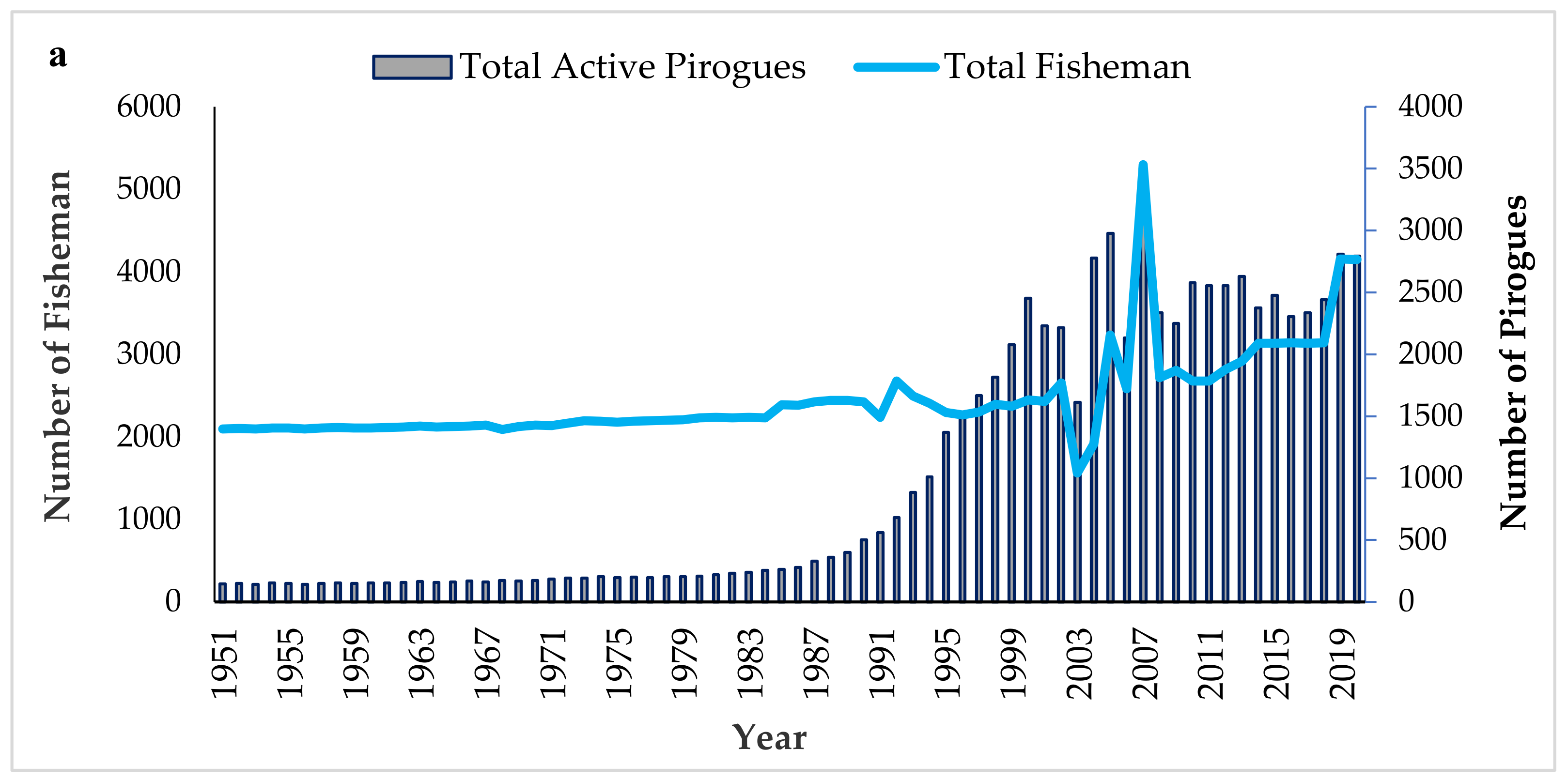
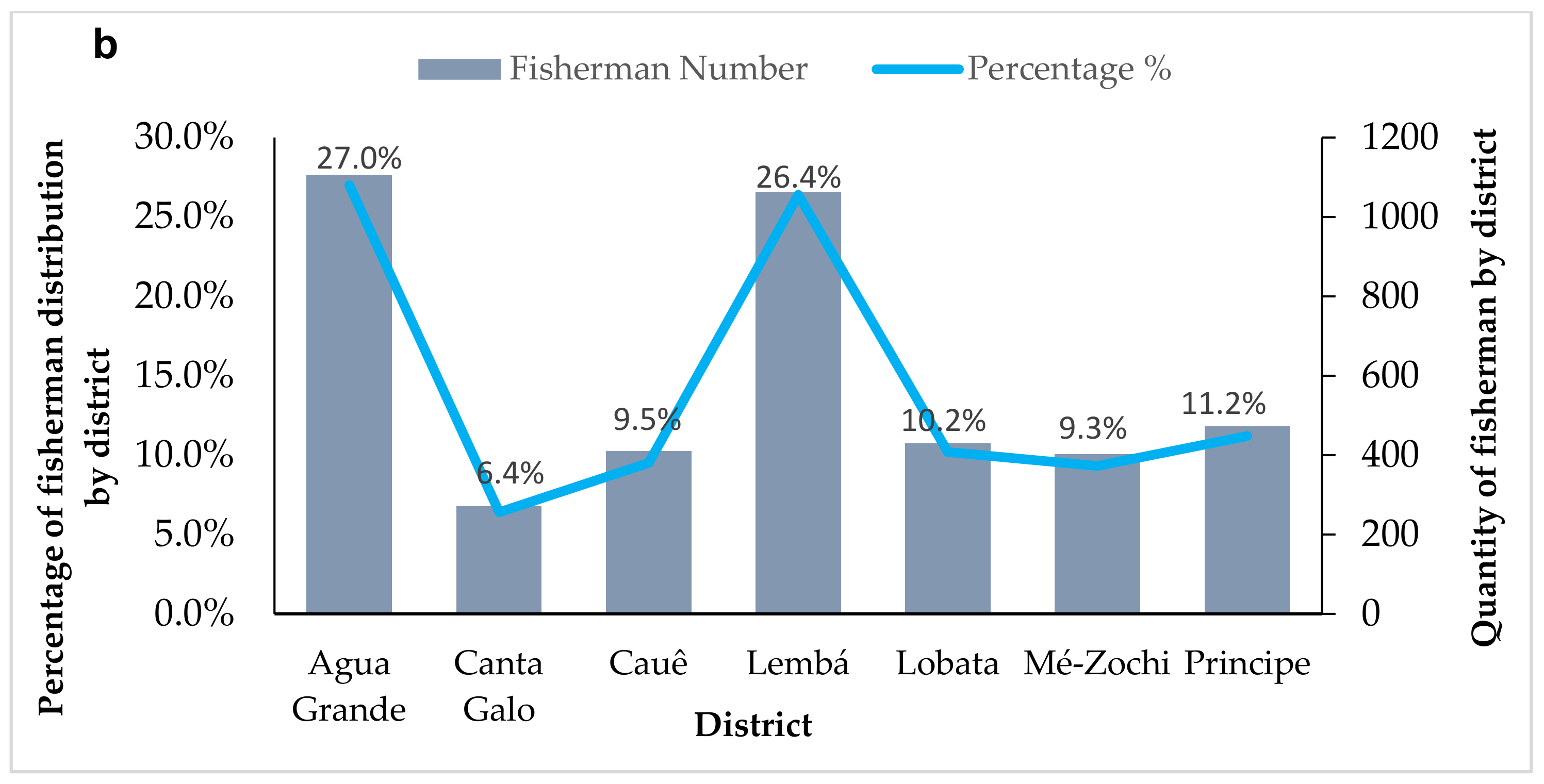
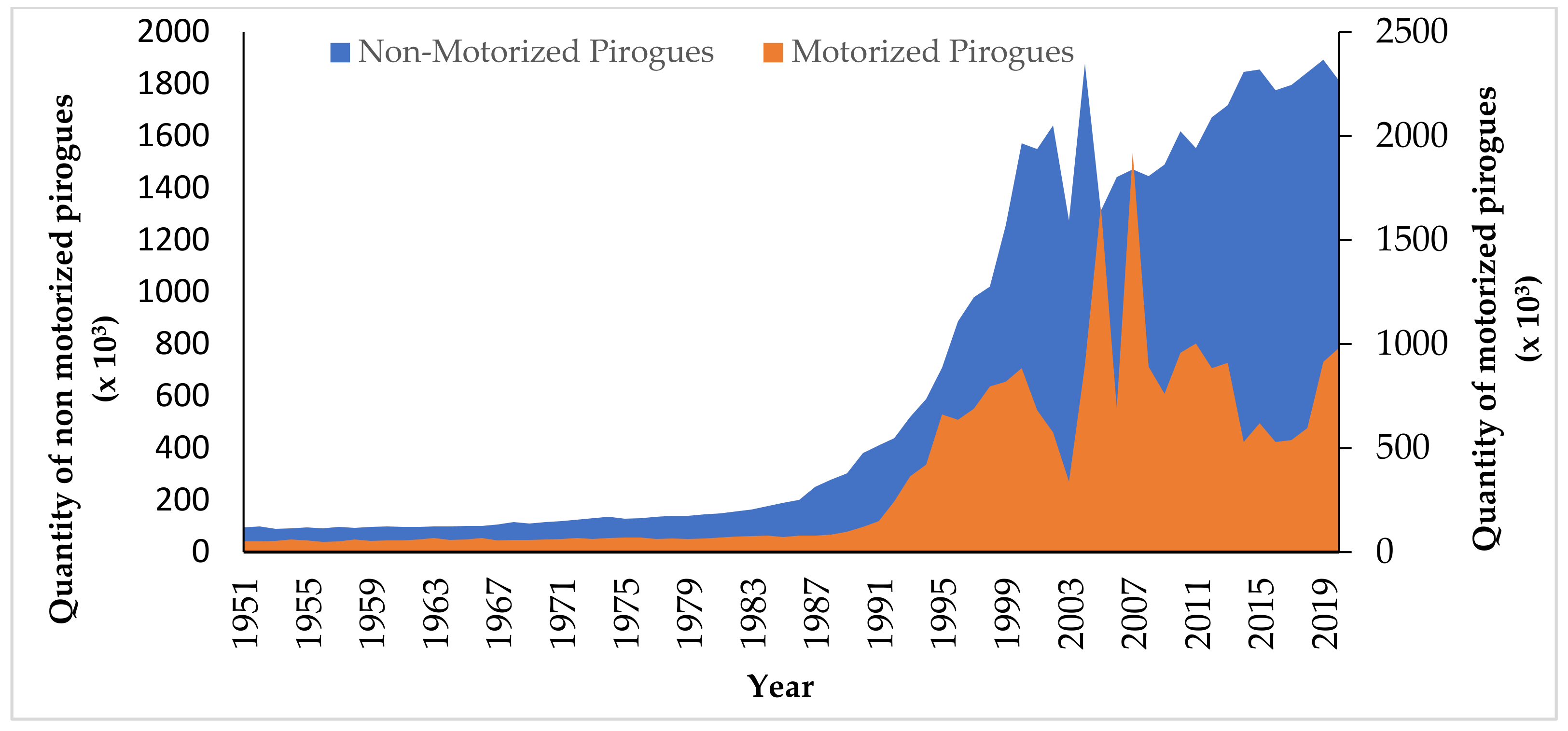
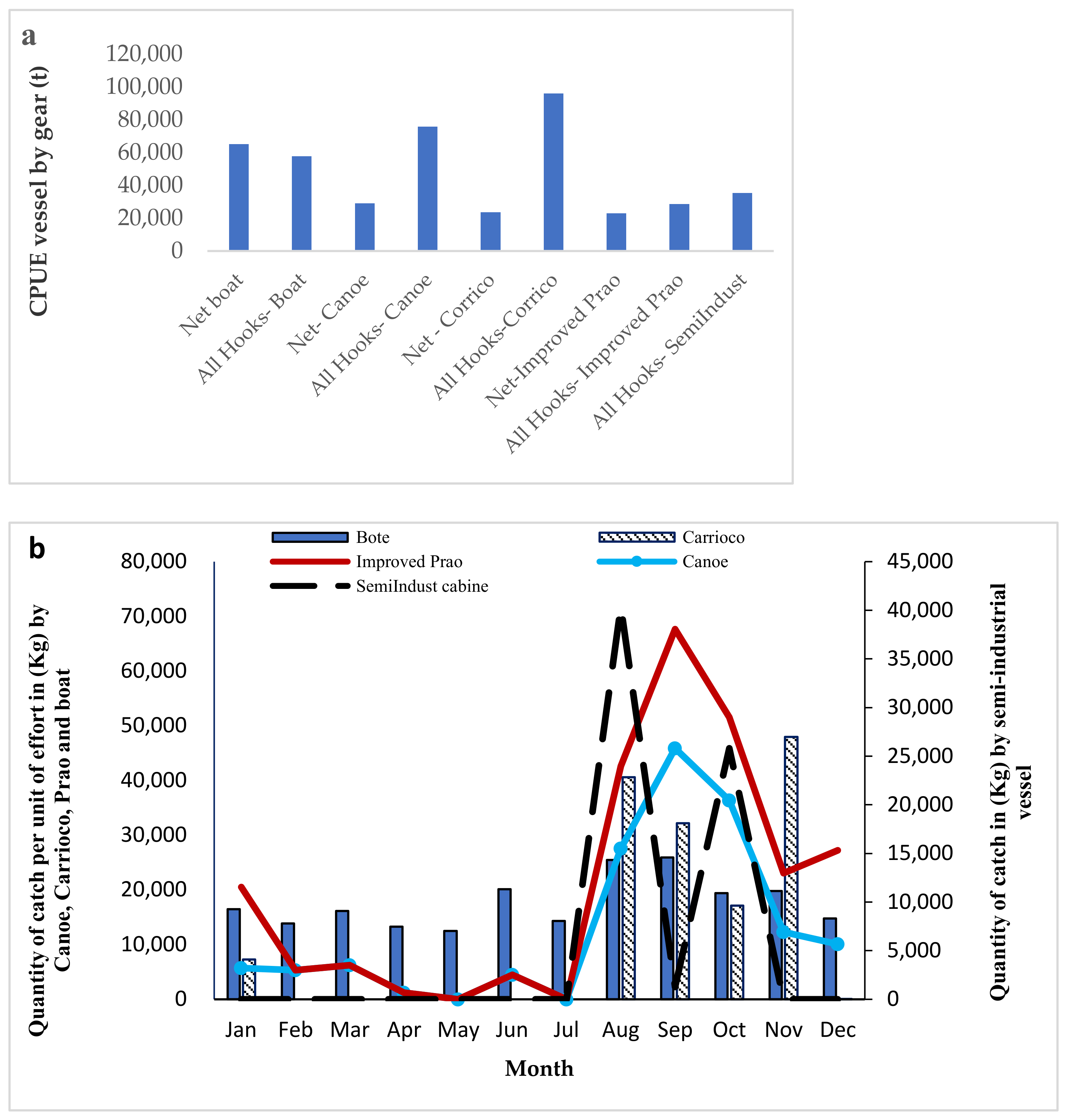
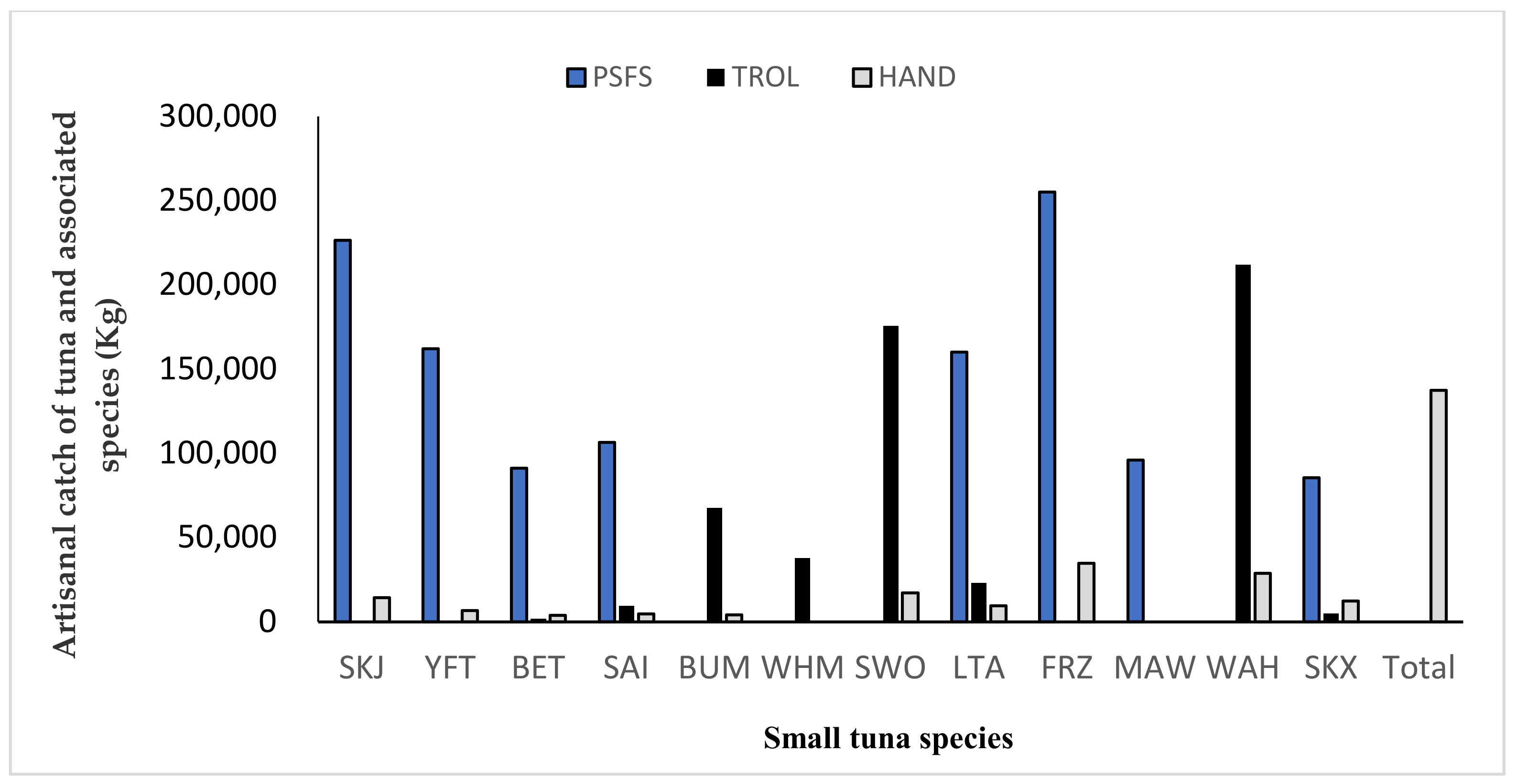
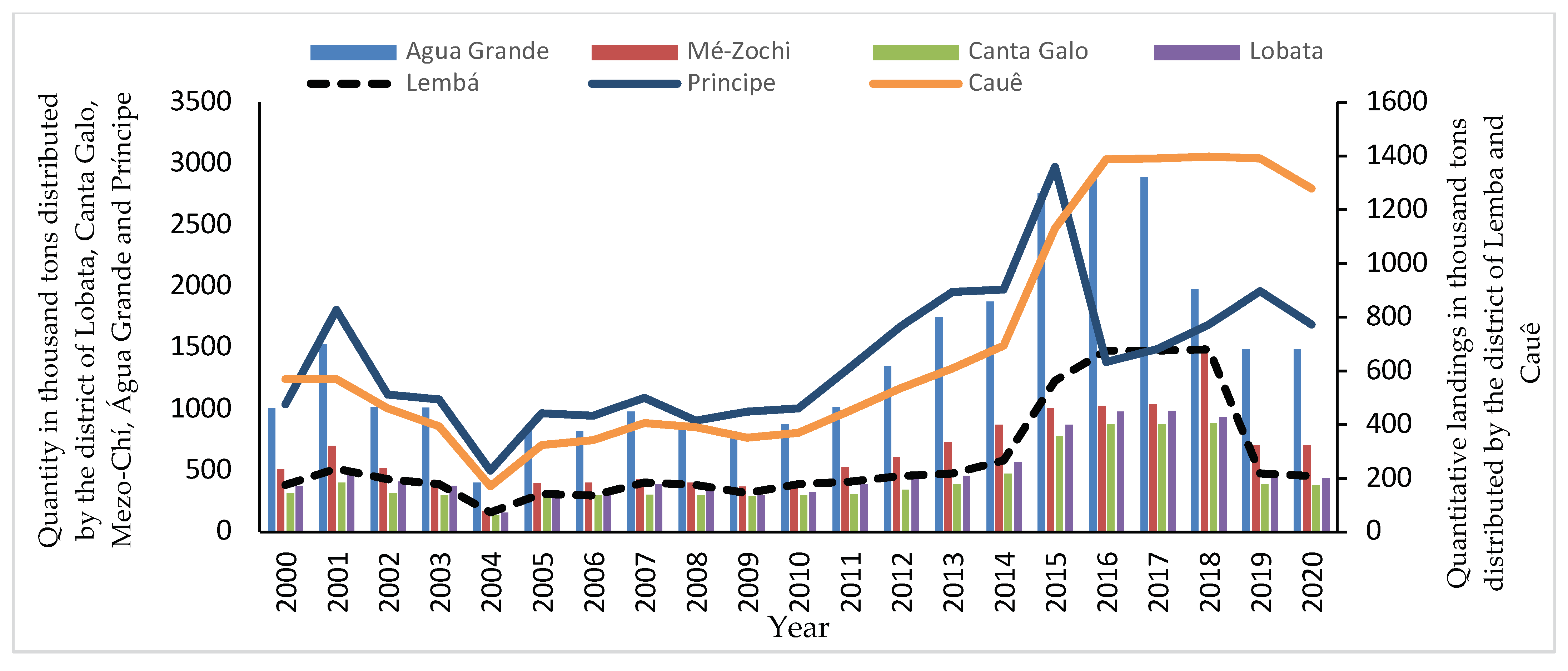
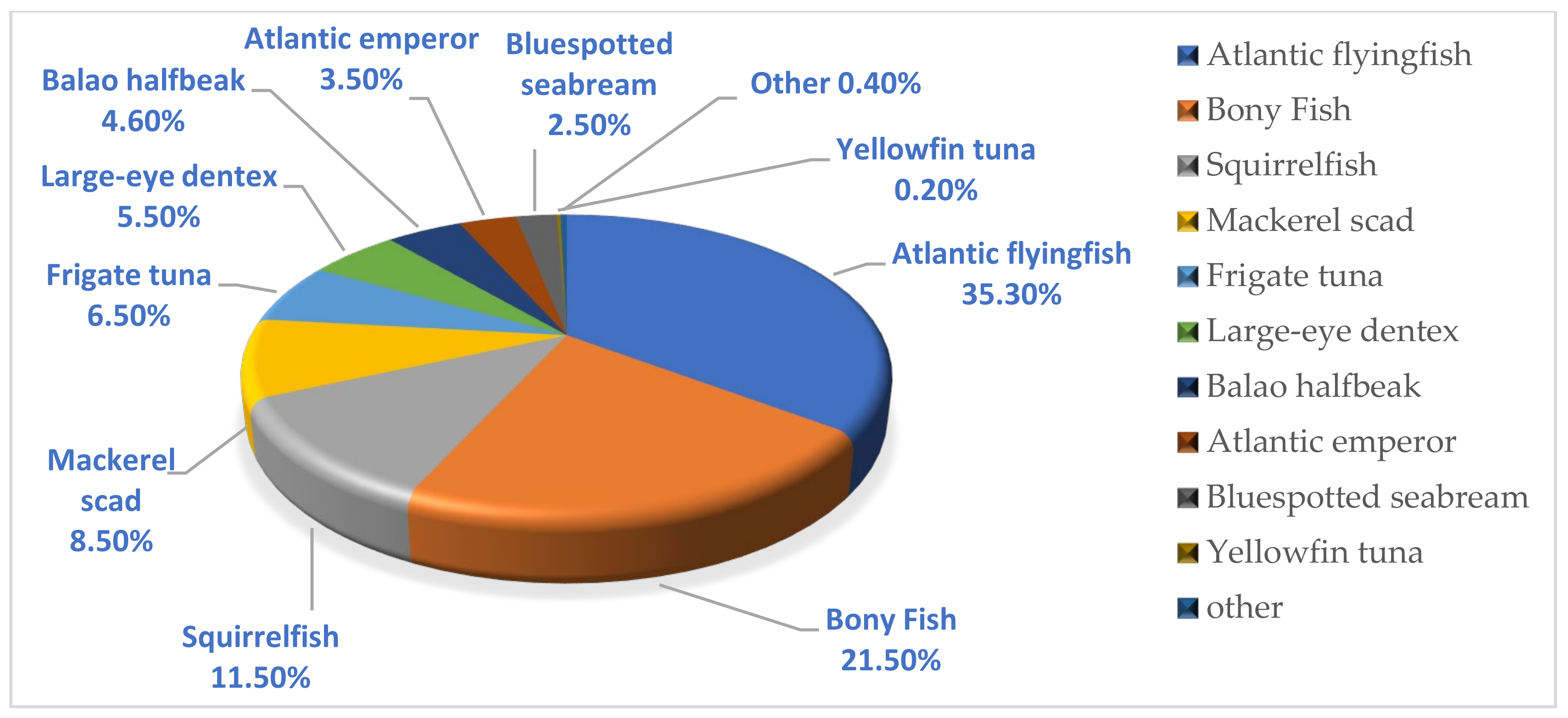

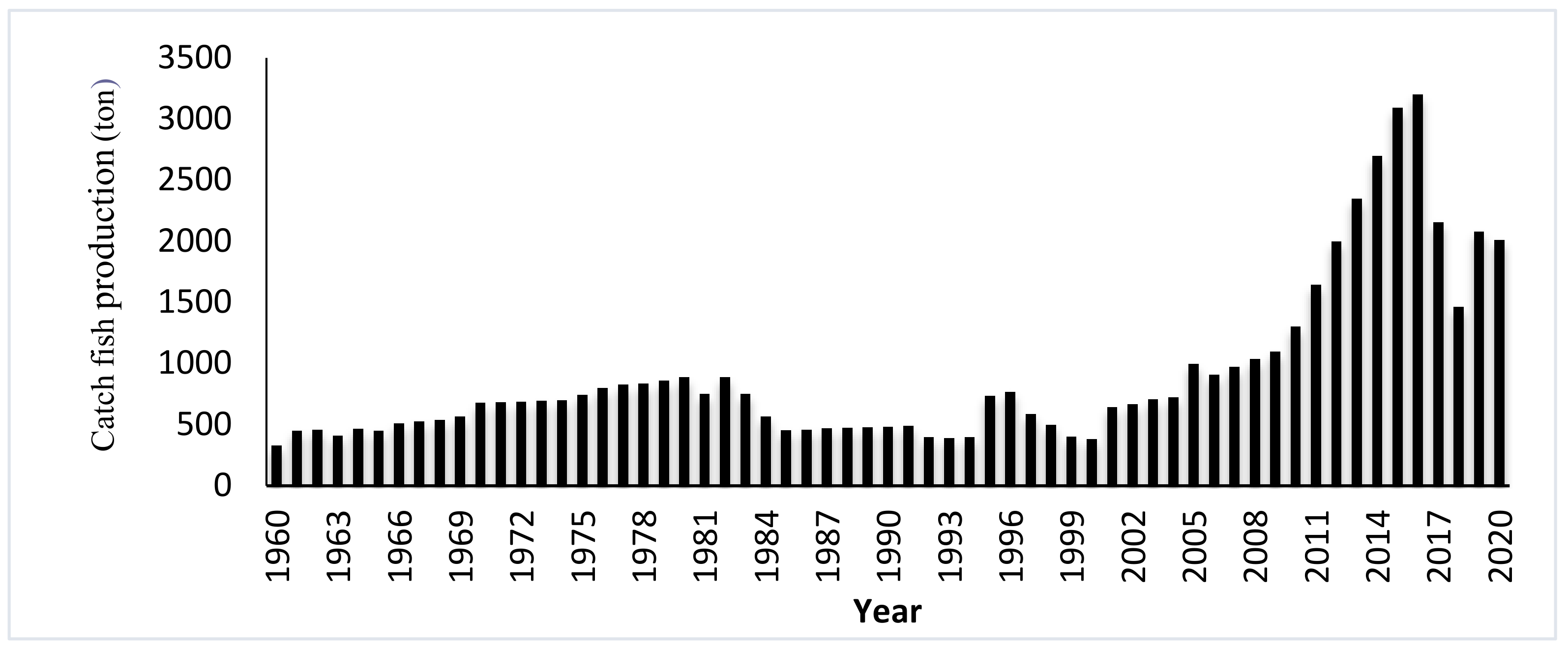
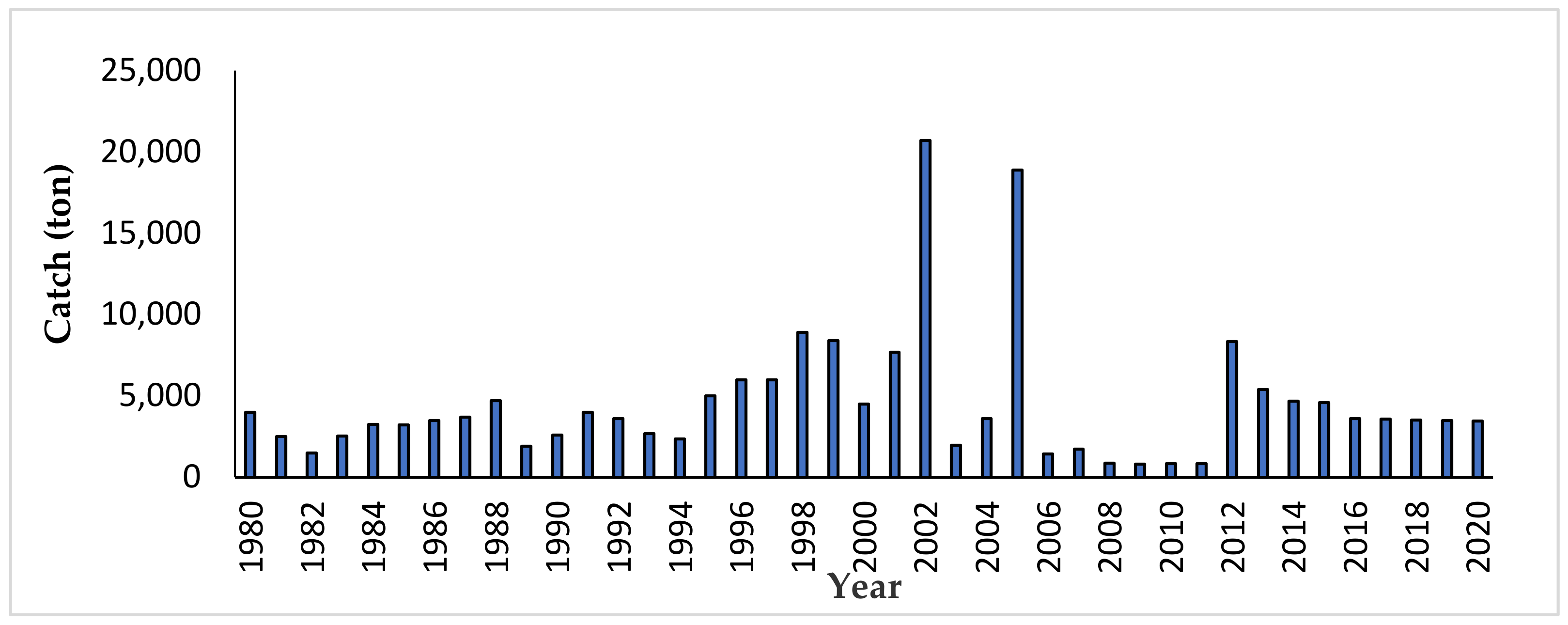

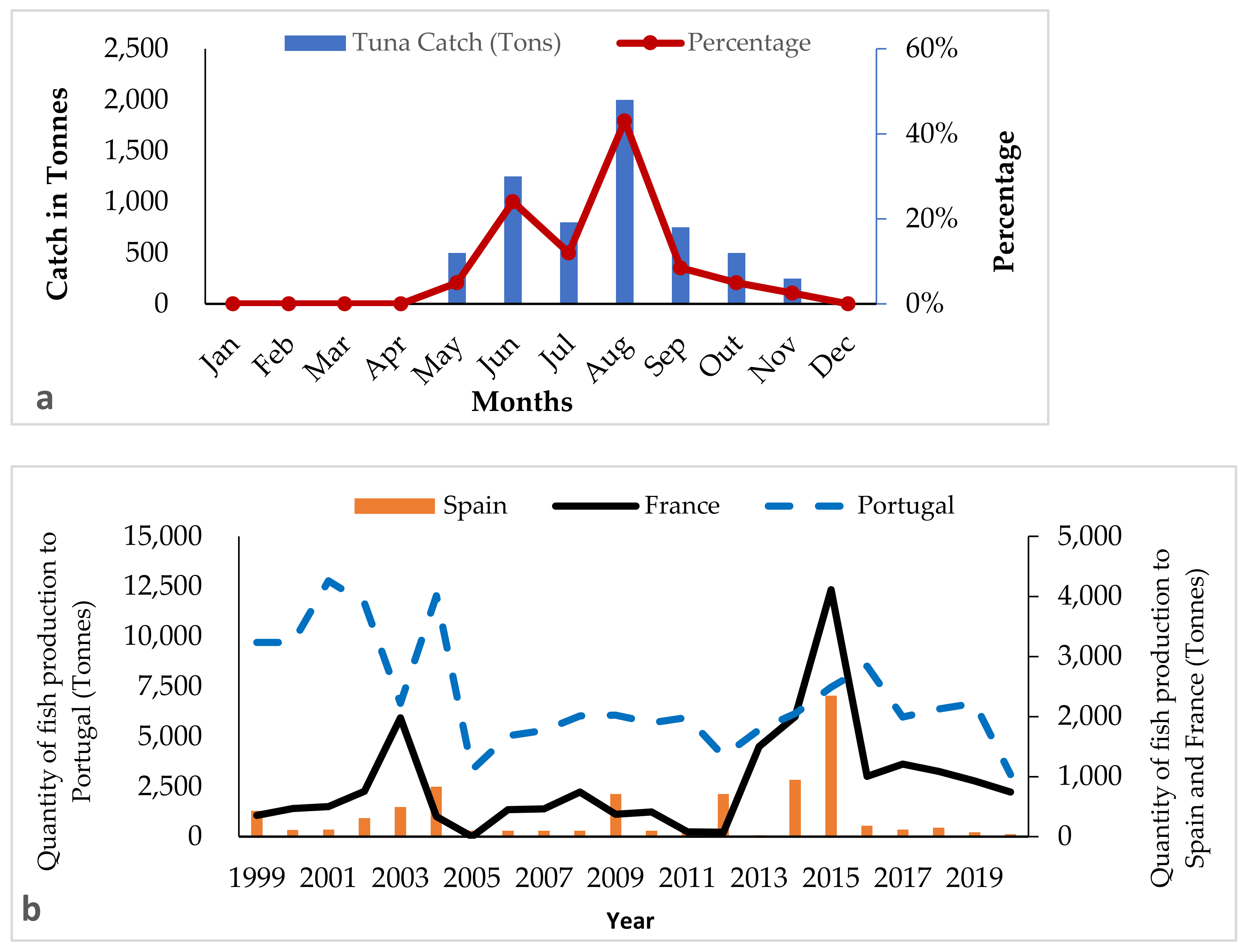
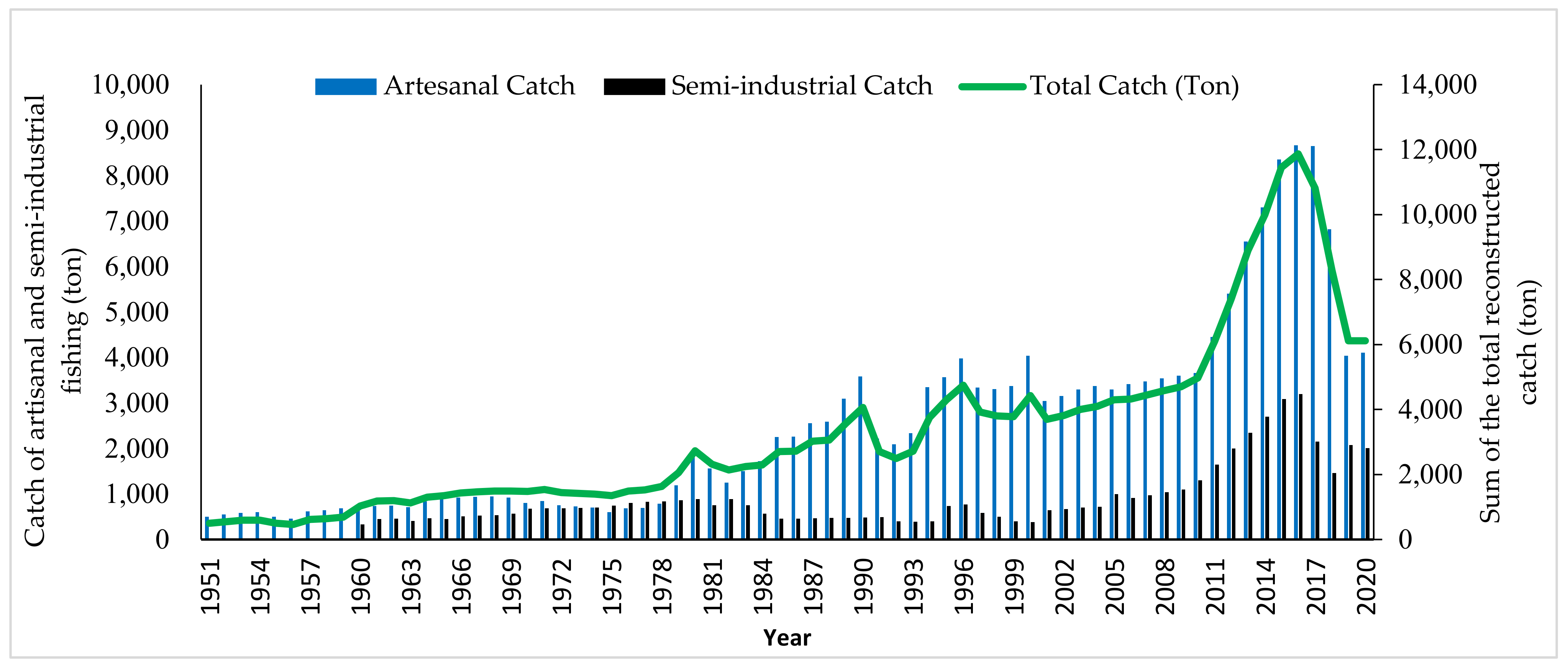
| Resource Groups | Potential in Tons/Year | MSY (%) |
|---|---|---|
| Large Pelagics/Tunas | 17,000 | 52.6% |
| Coastal pelagic | 4000 | 25.4% |
| Demersal Species | 2000 | 15.4% |
| Seafood | 6000 | 5.6% |
| Total | 29,000 | 100% |
| Location | Surface in km2 | Pelagic | Demersal | MSY/Catch % | TOTAL |
|---|---|---|---|---|---|
| São Tomé | 436 | 1500 | 1500 | 22% | 3000 |
| Principe | 1023 | 7000 | 2000 | 78% | 9000 |
| Total | 1455 | 8500 | 3500 | 100% | 12,000 |
| Type of Work | Year | |||||||||
|---|---|---|---|---|---|---|---|---|---|---|
| 1950 | 1960 | 1970 | 1980 | 1990 | 2000 | 2005 | 2010 | 2015 | 2020 | |
| Number of fishermen | 1000 | 2109 | 2140 | 2230 | 2427 | 2450 | 3233 | 2676 | 3132 | 4148 |
| Number of women sellers (palayê) | 1580 | 1689 | 1786 | 1889 | 3100 | 6000 | 893 | 2051 | 2858 | 2300 |
| Number of fishing canoes | 1748 | 1780 | 1805 | 1815 | 1840 | 2125 | 1613 | 2323 | 2374 | 2509 |
| Motorization rate (%) | 6% | 7% | 9% | 11% | 12% | 13% | 18% | 21% | 22% | 24% |
| Fishing Gear | Sum of Daily Trips | % | Daily Average | Daily Output | Daily Maximum |
|---|---|---|---|---|---|
| Flying Net | 210 | 33.5% | 11.7 | 5.2 | 24 |
| Panhá Flying Net | 0 | 0.0% | 0.0 | 0.0 | 0 |
| Purse Seine Net | 33 | 5.3% | 1.8 | 1.3 | 5 |
| Brisa Gillnet | 0 | 0.0% | 0.0 | 0.0 | 0 |
| Demersal Gillnet | 2 | 0.3% | 0.1 | 0.6 | 1 |
| Spearfishing | 80 | 12.8% | 4.4 | 2.7 | 9 |
| Line Fishing | 291 | 46.5% | 16.2 | 8.3 | 32 |
| Shore Line Fishing | 10 | 1.6% | 0.6 | 1.0 | 3 |
| Fishing Gear | Daily Trips | Capture (kg) | Trips Number | Average Catch per Trip (kg) | Daily Catch (kg) | Annual Catch (ton) |
|---|---|---|---|---|---|---|
| Surface Gillnet | 11.7 | 2493.7 | 80 | 31.2 | 364.7 | 133.1 |
| Voador panhá Net | 0 | NA | 0 | NA | 0.0 | 0.0 |
| Sena of Bolsa | 1.8 | 1921.8 | 28 | 68.6 | 123.5 | 45.1 |
| Gillnet | 0 | NA | 0 | NA | 0.0 | 0.0 |
| Demersal Gillnet | 0.1 | 12.5 | 5 | 2.5 | 0.3 | 0.1 |
| Deep-Searching | 4.4 | 170 | 11 | 15.5 | 68.0 | 24.8 |
| Line Fishing | 16.2 | 5337.13 | 293 | 44.2 | 295.1 | 107.7 |
Publisher’s Note: MDPI stays neutral with regard to jurisdictional claims in published maps and institutional affiliations. |
© 2022 by the authors. Licensee MDPI, Basel, Switzerland. This article is an open access article distributed under the terms and conditions of the Creative Commons Attribution (CC BY) license (https://creativecommons.org/licenses/by/4.0/).
Share and Cite
Zacarias, W.B.M.; Dai, X.; Kindong, R.; Sarr, O.; Moussa, A.H. Analysis of Fishery Resource Management Practices in São Tomé and Príncipe: Perception of the Dynamics of Catches from 1950–2020, Recommendations and Strategies for Future Research. Sustainability 2022, 14, 13367. https://doi.org/10.3390/su142013367
Zacarias WBM, Dai X, Kindong R, Sarr O, Moussa AH. Analysis of Fishery Resource Management Practices in São Tomé and Príncipe: Perception of the Dynamics of Catches from 1950–2020, Recommendations and Strategies for Future Research. Sustainability. 2022; 14(20):13367. https://doi.org/10.3390/su142013367
Chicago/Turabian StyleZacarias, Wilfred Boa Morte, Xiaojie Dai, Richard Kindong, Ousmane Sarr, and Abdoulrazack Hamoud Moussa. 2022. "Analysis of Fishery Resource Management Practices in São Tomé and Príncipe: Perception of the Dynamics of Catches from 1950–2020, Recommendations and Strategies for Future Research" Sustainability 14, no. 20: 13367. https://doi.org/10.3390/su142013367







